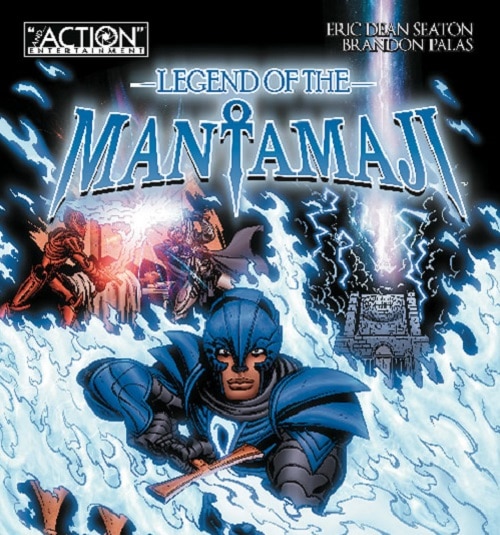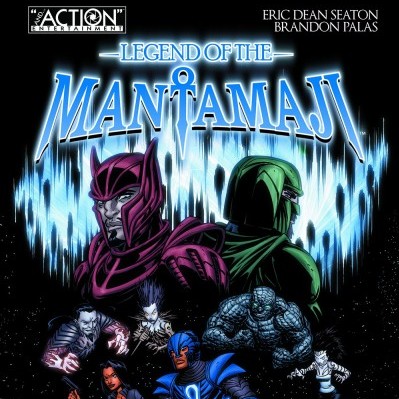It has been said before and it’s worth repeating — it is an AWESOME time to be a nerd — and for Black nerds, we are finally seeing more creators and characters of color push through in the graphic novel/superhero genre both in film and print, conglomerate and indie produced. This week is no exception.
“Legend of the Mantamaji: Book Two” published by And…Action! Entertainment is the second book in television director Eric Dean Seaton’s new graphic novel series. It was set for release on Dec. 10, 2014, “Book Two” brings new characters, lots of action and open-mouth-catch-flies twists.
In this series installment, Seaton has to carry the expectations that readers embraced in the first book in the series — a smart plotline, good pacing, great artwork, layered characters, lots of action and those darn plot twists that got us in the first book. He also has to work hard to avoid the pitfalls that plague the second anything in a planned trilogy. No one enjoys settling into a good second book or movie only to feel like the series was stalling for time until the good stuff happens in the final installment (looking at you Matrix Reloaded).
Fortunately, Seaton and his collaborative team have exceeded expectations with “Book Two.” Part of what makes “Book Two” work is continuity in the team that worked on “Book One.”
Eisner-nominated letterer Deron Bennett brings his talented pen to the piece with consistency and skill.
Artist Brandon Palas continues to produce fantastic work. The action scenes are epic, yet easy to follow and there are panels that you want to pull out simply to admire the work. Palas is also careful to avoid female “same face” that often happens to female characters in the superhero genre. If you listen to Seaton’s numerous interviews to date, he is adamant that the women in the series are every bit as powerful and influential as the men — a powerful declaration of his female characters’ value and purpose — which surely influenced Palas’ art direction.
Colorist Andrew Dalhouse brings Palas’ work to life with brilliant, focused color. There is real depth in his work and deliberation in color choices, from the body armor of the Mantamaji to the intricacies of the splash pages. His long-time experience with the big comic companies is evident and demonstrated throughout the series.
Seaton, of course, is the man behind the entire story that keeps readers engaged from page one. A critically acclaimed television director with 198 episodes and 38 series under his belt including hit shows like NBC’s Undateable, BET’s Reed Between the Lines, Disney’s Austin and Ally and Nickelodeon’s The Haunted Hathaways, Seaton manages to make each chapter of the book feel like both television show episodes and weekly editions of a comic book series. This creates nice stopping points, even though the book compels you to keep reading if you can hold off work, family and everything else for close to 200 pages.
Seaton also keeps the books very clean, with an eye on a wide audience range, he leaves out swearing and excessive violence. The books are listed as being for ages 9 and up.
The Good:
The Story: “The Legend of the Mantamaji” storyline is terrific with well-placed plot twists that keep readers guessing the entire time. Just when you think you have it all figured out, Seaton throws you for a loop. While this second book picks up where the first one left off, you don’t have to read “Book One” ahead of “Book Two,” BUT without “Book One” you miss much of the backstory that marries the ancient African warrior vibe with modern-day resurgence of the Mantamaji very well. It does have the signature middle book cliffhanger, but you never feel like you’ve wasted your time. “Book Two” is definitely not a standalone book in the sense that you can get to the end and be completely satisfied. Readers will want to pre-order “Book Three” for February release.
The Characters: Seaton continues to supply his characters with interesting backstories and opportunities to rise or fall down on the job. He even instills humor as a way to help readers identify with all of his characters, good and bad alike.
We learn more about top cop Sydney who continues to hold her own against the city’s bad guys — in the occasional party dress no less. The social media popular Sanctuants, the sisters to the Mantamaji, reappear as well. And fortunately, we don’t see any butt to the camera fighting action that seems to be the pose du jour for female characters in the superhero genre.
The Action: Most of the action involves the Four Horsemen who are as intimidating as their names. The battles between the four and Elijah spill all over the place — the city, the woods … it’s exhausting and rewarding at the same time as Seaton has been teasing the Horsemen as a part of his social media campaign since before the first book launch. We also get to finally see the rebirth of Sirach, which is both frightening and intense.
The OK:
The Dialogue: As previous reviewers have mentioned, the dialogue can get a bit stilted. Some of it works with specific characters, other times it feels not as natural as you would expect in something that is clearly very modern.
Overall, “Legend of the Mantamaji: Book Two” lives up to the hype and at $14.99 is worth the investment. Unlike many indie works, the series is available in all formats [except braille and audio] and through a variety of sellers including Amazon, Barnes and Noble stores and online, Comixology, iTunes, comic book stores and the “Legend of the Mantamaji” website. Previews of all three books are also available at the “Legend of Mantamaji” website and on Amazon.
Source: Terreece M. Clarke at legendofthemantamaji.com







